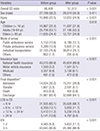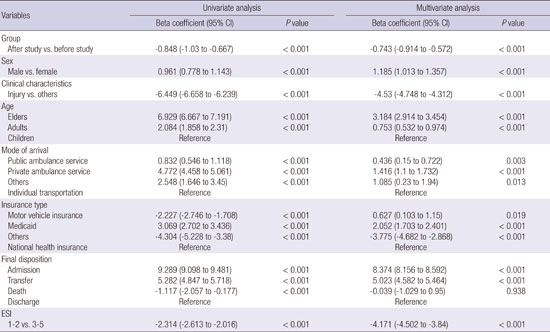2. McCaig LF, Nawar EW. National Hospital Ambulatory Medical Care Survey: 2004 emergency department summary. Adv Data. 2006; 23:1–29.
3. Derlet RW, Richards JR. Overcrowding in the nation’s emergency departments: complex causes and disturbing effects. Ann Emerg Med. 2000; 35:63–68.
4. Sprivulis PC, Da Silva JA, Jacobs IG, Frazer AR, Jelinek GA. The association between hospital overcrowding and mortality among patients admitted via Western Australian emergency departments. Med J Aust. 2006; 184:208–212.
5. Singer AJ, Thode HC Jr, Viccellio P, Pines JM. The association between length of emergency department boarding and mortality. Acad Emerg Med. 2011; 18:1324–1329.
6. Asplin BR, Magid DJ, Rhodes KV, Solberg LI, Lurie N, Camargo CA Jr. A conceptual model of emergency department crowding. Ann Emerg Med. 2003; 42:173–180.
7. Moskop JC, Sklar DP, Geiderman JM, Schears RM, Bookman KJ. Emergency department crowding, part 1--concept, causes, and moral consequences. Ann Emerg Med. 2009; 53:605–611.
8. Schneider S, Zwemer F, Doniger A, Dick R, Czapranski T, Davis E. Rochester, New York: a decade of emergency department overcrowding. Acad Emerg Med. 2001; 8:1044–1050.
9. Pines JM, Hilton JA, Weber EJ, Alkemade AJ, Al Shabanah H, Anderson PD, Bernhard M, Bertini A, Gries A, Ferrandiz S, et al. International perspectives on emergency department crowding. Acad Emerg Med. 2011; 18:1358–1370.
10. Kim KW, Kim SH, Park KN, Kim HJ, Oh SH, Lee JY, Lee JM, Im JY. Mid-term effects of tertiary hospital beds expansion on emergency department overcrowding. J Korean Soc Emerg Med. 2014; 25:722–729.
11. Viccellio P. Emergency department overcrowding: an action plan. Acad Emerg Med. 2001; 8:185–187.
12. Viccellio A, Santora C, Singer AJ, Thode HC Jr, Henry MC. The association between transfer of emergency department boarders to inpatient hallways and mortality: a 4-year experience. Ann Emerg Med. 2009; 54:487–491.
14. Garson C, Hollander JE, Rhodes KV, Shofer FS, Baxt WG, Pines JM. Emergency department patient preferences for boarding locations when hospitals are at full capacity. Ann Emerg Med. 2008; 51:9–12. 12.e1–12.e3.
15. Villa-Roel C, Guo X, Holroyd BR, Innes G, Wong L, Ospina M, Schull M, Vandermeer B, Bullard MJ, Rowe BH. The role of full capacity protocols on mitigating overcrowding in EDs. Am J Emerg Med. 2012; 30:412–420.
16. Talleshi Z, Hosseininejad SM, Khatir G, Bozorghi F, Gorji AM, Gorji MA. The effect of new emergency program on patient length of stay in a teaching hospital emergency department of Tehran. Niger Med J. 2014; 55:134–138.
17. Shih FY, Ma MH, Chen SC, Wang HP, Fang CC, Shyu RS, Huang GT, Wang SM. ED overcrowding in Taiwan: facts and strategies. Am J Emerg Med. 1999; 17:198–202.
18. Cha WC, Shin SD, Song KJ, Jung SK, Suh GJ. Effect of an independent-capacity protocol on overcrowding in an urban emergency department. Acad Emerg Med. 2009; 16:1277–1283.
19. Freedman SB, Thakkar VA. Easing the strain on a pediatric tertiary care center: use of a redistribution system. Arch Pediatr Adolesc Med. 2007; 161:870–876.
20. Schneider SM, Asplin BR. Global crowding: opportunities for regionalization in emergency care. Acad Emerg Med. 2009; 16:1333–1334.
21. Kocher KE, Sklar DP, Mehrotra A, Tayal VS, Gausche-Hill M, Myles Riner R. 2010 Academic emergency medicine consensus conference beyond regionalization: intergrated networks of emergency care. Categorization, designation, and regionalization of emergency care: definitions, a conceptual framework, and future challenges. Acad Emerg Med. 2010; 17:1306–1311.
22. Henry TD, Sharkey SW, Burke MN, Chavez IJ, Graham KJ, Henry CR, Lips DL, Madison JD, Menssen KM, Mooney MR, et al. A regional system to provide timely access to percutaneous coronary intervention for ST-elevation myocardial infarction. Circulation. 2007; 116:721–728.
23. Spaite DW, Bobrow BJ, Stolz U, Berg RA, Sanders AB, Kern KB, Chikani V, Humble W, Mullins T, Stapczynski JS, et al. Statewide regionalization of postarrest care for out-of-hospital cardiac arrest: association with survival and neurologic outcome. Ann Emerg Med. 2014; 64:496–506.e1.
24. LaMonte MP, Bahouth MN, Magder LS, Alcorta RL, Bass RR, Browne BJ, Floccare DJ, Gaasch WR; Emergency Medicine Network of the Maryland Brain Attack Center. A regional system of stroke care provides thrombolytic outcomes comparable with the NINDS stroke trial. Ann Emerg Med. 2009; 54:319–327.







 PDF
PDF ePub
ePub Citation
Citation Print
Print







 XML Download
XML Download